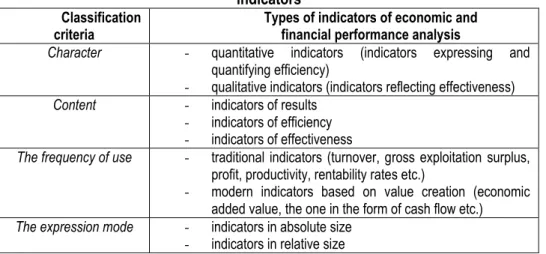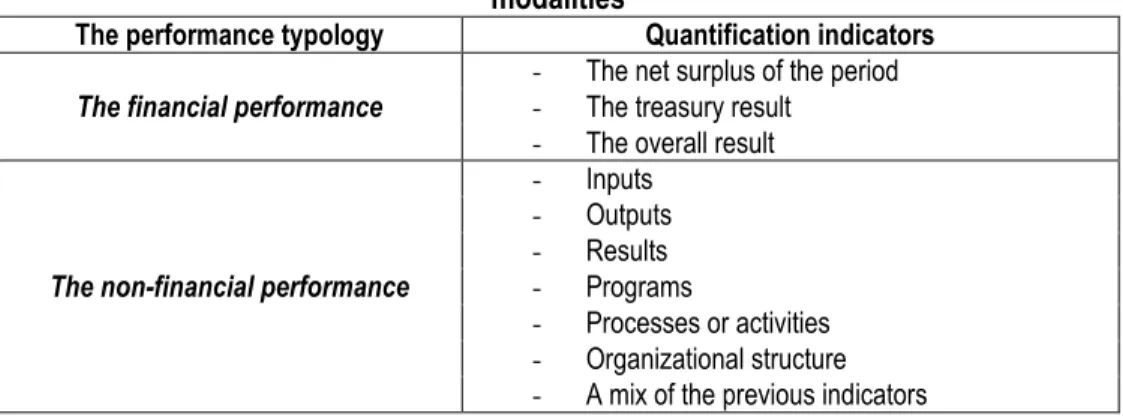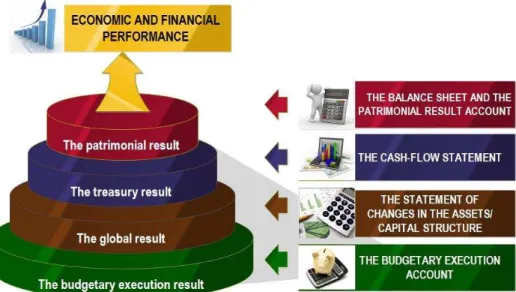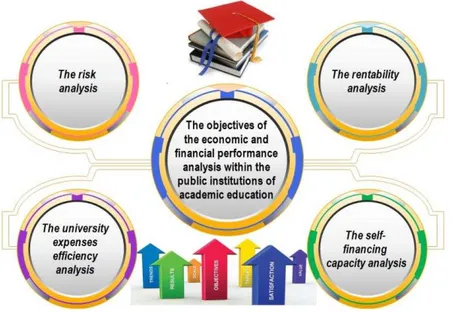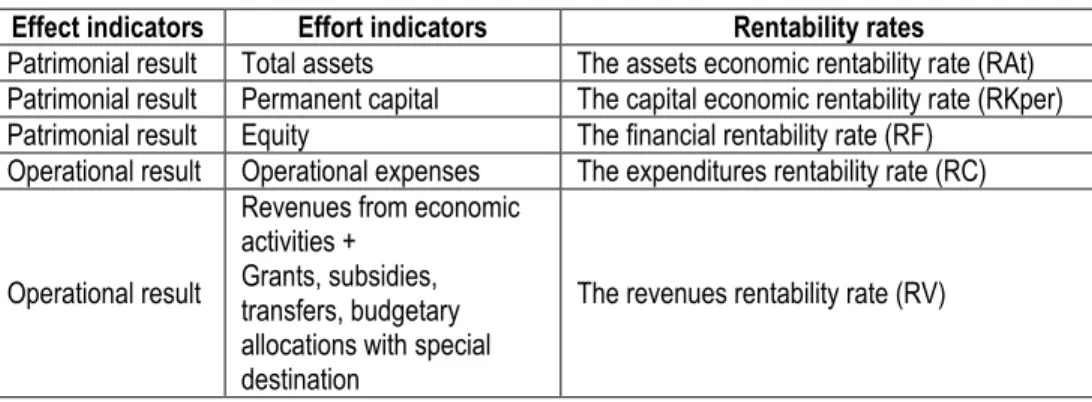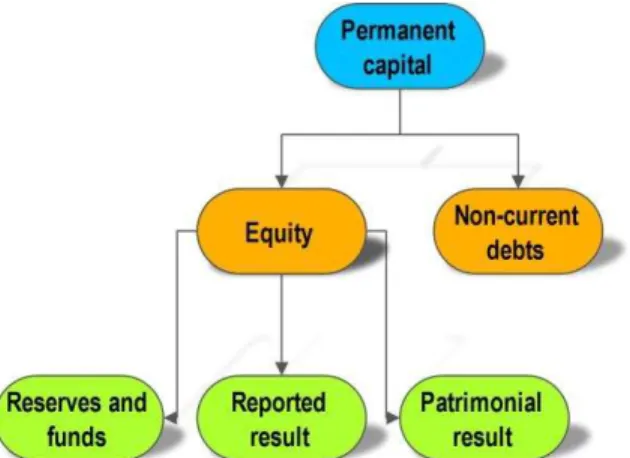INDICATORS
OF
THE
ECONOMIC
AND
FINANCIAL
PERFORMANCE
FOR
THE
PUBLIC
UNIVERSITIES
IN
ROMANIA
Assist. Cristina-Petrina Trincu-Drăgușin Ph. D University of Craiova
Faculty of Economics and Business Administration Craiova, Romania
Prof. Magdalena Mihai Ph. D University of Craiova
Faculty of Economics and Business Administration Craiova, Romania
Assoc. Prof. Luis Blanco-Pascual Ph. D University of ”La Rioja”
Faculty of Business Sciences Logroño, Spain
Abstract: Quantifying the economic and financial performance in public universities represents a current, very interesting and quite a controversial matter of debate given that the accounting information realm is not sufficient explored through the financial analysis. The paper focuses on the ways of measuring the economic and financial performance in public universities in Romania, having as main purpose to provide a set of assessing indicators, by adapting the financial analysis paradigm existing for the private sector, to the public sector particularities. The specific objectives refer to the rentability, self-financing capacity, efficiency of the university expenditures and risk analysis, and the research approach is developed in the context in which either the national law or the international one do not regulate specific indicators for the economic and financial performance analysis within the public sector institutions.
JEL classification: H52, I23.
Key words: economic and financial performance; performance measurement; performance indicators; universities; public sector.
1. INTRODUCTION
It becomes necessary for the economic and financial performance of the public sector institutions to be quantified and analyzed, starting from the principle according to which you can control and improve only what it is known.
order to determine precisely the place which they occupy in relation to the competing entities, the advantages they have and also the present and potential threats. Practically, in order to prevent the difficult moments and the drastic decisions, with negative impact on all the actors involved in the academic education, the university managers want to analyze how their decisions have been implemented and which are the consequences of the obtained results, to decide later the way forward.
Another important aspect refers to the fact that performance cannot be qualified in isolation, but rather it should always be addressed by reference to a mark, through a comparison process. In this regard, defining and choosing the comparison criteria are important. As Siminică considers (2010, p. 114), highlighting performance can be achieved only by comparison with other obtained results because being performant means to reach or to exceed the proposed objectives. However, in his opinion, the objectives to be achieved are not the only referential which can be chosen for comparison. Regarding this issue, the authors Coste and Tudor-Tiron (2013, p. 218) believe that, for measuring the performance, the comparisons with public organizations offering the same type of services would be helpful. In turn, Ganea (2012, p. 72) considers that the performance measurement process involves not only the activity of quantifying and presenting performance through a number or a value associated with various indicators, but also the action of comparison, of reporting to a referential (internal or external, previously made or programmed) in order to determine the institution actions efficiency or inefficiency.
Therefore, we cannot approach the economic and financial performance of an entity only if we analyze, quantify and relate it to a referential, through a comparative process. By adapting to the modern society requirements, which is rapidly changing and evolving, communicating the obtained results and comparing them both with endogenous elements (results of a previous period) and exogenous elements (results achieved by other comparable entities) must become a current practice for all the public institutions, as an essential lever to progress.
Given that referring to a benchmark becomes one of the essential requirements of the performance notion, it is necessary to mention that the referential selected as comparison basis and the performance itself have a dynamic character in the value creation process. Therefore, we consider that an entity can be performant only to the extent in which it becomes capable of augmenting its positive results in the future.
2. METHODOLOGY
Our investigative itinerary results in a qualitative research, customized on the ways of assessing and measuring the economic and financial performance in Romanian public universities.
3. LITERATURE REVIEW
In general, in order to analyze the performance of an entity, various categories of indicators, both quantitative and qualitative, covering all the aspects of its activity, should be taken into account. These indicators provide not only to management, but also to third parties, particularly useful information regarding the efficiency of production, service provision and commerce activity, the material, human and financial resources management efficiency, the achieved rentability and the entity value increase between the studied period. The indicators system also facilitates the identification of strengths and weaknesses that characterize the deployed activity and depending on which the decisions to improve performance in the future are made.
An alternative for classifying the indicators which can be taken into consideration for the analysis of an entity economic and financial performance is presented in Table 1.
Table no. 1 – The classification of the economic and financial performance analysis indicators
Classification criteria
Types of indicators of economic and financial performance analysis
Character - quantitative indicators (indicators expressing and quantifying efficiency)
- qualitative indicators (indicators reflecting effectiveness) Content - indicators of results
- indicators of efficiency - indicators of effectiveness
The frequency of use - traditional indicators (turnover, gross exploitation surplus, profit, productivity, rentability rates etc.)
- modern indicators based on value creation (economic added value, the one in the form of cash flow etc.) The expression mode - indicators in absolute size
- indicators in relative size
Source: Processing after Siminică, M. (2010). Diagnosticul financiar al firmei. Craiova: Editura Sitech, p. 121.
The specialty literature presents and develops numerous indicators for measuring the economic and financial performance. Without issuing claims of exhaustiveness, after consulting numerous papers of the autochthonous specialists such as Buşe, Marcu, Lala Popa, Miculeac, Siminică, Ganea, Cîrciumaru, Robu, Anghel, Şerban, we consider that the main indicators of analyzing the economic and financial performance are those shown in Figure 1.
Regarding the public sector in general and the academic education public system in particular, the period in which the institutions performance could have been assessed only through the legal and regulatory compliance is obsolete. Lately, more and more emphasis is put on analyzing and quantifying performance through indicators, the feed-back providing the decisions making in order to improve the institutional performances or their design with innovative parameters.
Source: Own projection
Figure no. 1 – The main indicators for analyzing the economic and financial performance
As Mihaiu (2014, p. 40) also recognizes, the performance in the public sector meets many obstacles: from the concept definition and identification of suitable performance indicators to implementing a performance management system. Moreover, identifying and quantifying the economic and financial performance are not at all easy demarches, while the realm of the information disseminated through the public institutions accounting is not sufficiently explored by the financial analysis.
Table no. 2 – The public sector institutions performance: typology and quantifying modalities
The performance typology Quantification indicators
The financial performance
- The net surplus of the period - The treasury result
- The overall result
The non-financial performance
- Inputs - Outputs - Results - Programs
Source: Processing after Ştefănescu, A. et al. (2010). Controverse privind măsurarea performanţei entităţilor administraţiei publice din România, Revista Transilvană de Ştiinţe Administrative, 1(25), p. 231.
Noticing that things start to get increasingly complicated, we can affirm that
identifying the most appropriate methods to assess and monitor the performance in the public sector is a challenge more actual than ever.
4. INDICATORS FOR THE ANALYSIS OF THE PUBLIC UNIVERSITIES ECONOMIC AND FINANCIAL PERFORMANCE
According to Southern Utah University (2011), in general, to assess the economic and financial performance of a higher education institution, the revenues and expenditures declared through the periodic summary reports must be analyzed, since they reflect, in financial terms, the activities of training, research, public services, academic support, student services, support provided to students and the buildings exploitation and maintenance.
Source: Own processing after Ştefănescu, A. et al. (2010). Controverse privind măsurarea performanţei entităţilor administraţiei publice din România, Revista Transilvană de Ştiinţe Administrative, 1(25), p. 238.
Figure no. 2 - Quantifying the economic and financial performance of the public institutions of academic education through the components of the periodic summary
reports
In our country, the informational support in the process of assessing the economic and financial performance of the public institutions of academic education is provided by the components of the periodic summary reports as follows (Figure 2):
the balance sheet provides useful information regarding the economic and financial performance through the patrimonial result, indicator included in the category of equity;
economic and financial performance also through the patrimonial result, but calculated according to the accrual accounting principles, as difference between revenues and expenditures;
the cash flow statement provides information regarding the academic education institution cash-flow achieved from the operational, investing and financing activities; if in the first case, the cash flows are generated by the evolution of the liquidities from the current activity, in the second situation, they are the consequence of the cash fluctuation resulting from the fixed assets purchase or disposal; instead, the cash-flow related to the financing activity reflects the cash movements generated mainly by contracting and refunding loans; basically, this component of the periodic summary reports provides useful and rich in significance information not only for the university, but also for the third parties, as it allows assessing the institution degree of liquidity through the treasury result;
the statement of changes in the assets/capital structure allows the assessment of the economic and financial performance of a university through the global result, because it disseminates information regarding the equity structure, the accounting policies changes impact, the depreciation calculation and recording, the fixed assets revaluation and the accounting errors correction;
in turn, the budgetary execution account highlights the budgetary execution result determined on the cash accounting principles, by comparing the collections with the payments, on the subdivisions of the budgetary classification in force.
Source: Drăgușin, C.P. (2016). Management financiar-contabil în instituțiile publice de educație academică. București: Editura Economică, p. 252.
Figure no. 3 - The objectives of the economic and financial performance analysis within the public institutions of academic education
collected not only from the explanatory notes of the periodic summary reports, but also from other complementary sources.
In the followings, we shall provide a set of indicators for assessing the economic and financial performance in the public institutions of academic education, by adapting, to the public sector particularities, the existing paradigm of financial analysis for the private sector. For a systematic approach, in our demarche, we shall pursue the objectives presented in Figure 3.
Starting from the useful information provided to us not only by the balance sheets, but especially by the universities patrimonial results accounts, a first step in their performances analysis is to determine the rentability indicators. In relation to the expression mode, the rentability indicators can be absolute and relative indicators.
At the level of public institutions of academic education, the absolute indicators of rentability are called results; their typology and their way of determination can be presented schematically through Table 3.
The result from the operational activity (Ro) reflects the surplus or deficit obtained from the basic activity of the university and is determined, starting from the information provided by the patrimonial result account, by comparing the operational revenues with the operational expenses:
(1)
Table no. 3 – The table of the rentability absolute indicators
Revenues indicators Expenditures indicators Results
+ Operational revenues - Operational expenses Result from the operational activity (Ro)
+ Financial revenues - Financial expenses Result from the financial activity (Rf)
+ Current revenues - Current expenses Result from the current activity (Rc)
+ Extraordinary revenues - Extraordinary expenses Result from the
extraordinary activity (Rex)
+ Total revenues - Total expenses The patrimonial result of the year (Rp)
+ Revenues from economic activities
+ Grants, subsidies, transfers, budgetary allocations with special destination
- Expenses with stocks, works and services provided by third parties - Staff expenses
- Subsidies and transfers - Other operational expenses
The gross operational surplus (EBO)
Source: Adaptation after Cârstina, S. (2015). Gestiunea activelor şi rentabilitatea întreprinderii. Craiova: Editura Universitaria, p. 77.
The result from the financing activity (Rf) represents the surplus or the deficit subsequent to the economic operations with financial character, ordinary, iterative and specific, determined as difference between the financial incomes and the financial expenses:
(2)
The operational result and the financial result allow the determination of the current surplus or deficit (Rc), according to the following formula:
(3)
The result from the extraordinary activity (Rex) reflects the surplus or the deficit resulted from the accidental economic operations, unrelated to the higher education institution basic activity. This type of result is determined by comparing the extraordinary revenues with the extraordinary expenditures:
(4)
At this level, the patrimonial result of the year (Rp) can be determined either by deducting the total expenses from the total incomes, by summing the results obtained from the three activities or by cumulating the current result with the extraordinary surplus or deficit.
(5)
(6)
The patrimonial result is an economic one and reflects, absolutely, the rentability of a university, at the level of all the economic activities that are carried out within it.
The gross operational surplus (EBO) reflects the gross economic result obtained from the operational activity of the public higher education institution and is determined as difference between the operational revenues and the operational expenses involving collections and payments, made or potential.
In the category of the operational revenues involving collections, we include the incomes from economic activities (Vae) and the revenues from grants, subsidies, transfers and budgetary allocations with special destination (FSTAB). Thus, from the operational revenues category, other operational incomes will not be taken into consideration.
On the other hand, the expenditures involving payments consist of the expenses with stocks, works and services provided by third parties (SLSET), staff expenses (Cp), subsidies and transfers (ST) and also other operational expenses (ACo). Thus, from the category of the operational expenditures, the capital expenditures, depreciations and provisions will be ignored.
(7)
By adapting the vision of Siminică (2010, p. 144) we can characterize the gross operational surplus as the potential monetary surplus (the potential cash-flow) released from the current activity of the public institution of academic education, due to the temporal gaps between payments and receipts arising from the use of the stable liabilities (suppliers, staff, state budget) and, respectively, from the granted commercial loans.
Expressing rentability through the relative indicators is made starting from the general equation of the efficiency, by comparing the effect obtained with the institution effort to achieve that effect (Cârstina, 2015, p. 78).
We consider appropriate to present the typology and the expression mode of the rentability relative indicators in the case of the academic education public institutions through Table 4.
The assets economic rentability rate (RAt) is presented as a ratio between the patrimonial result and the total assets (non-current assets and current assets), providing useful information regarding the university heritage management.
Table no. 4 – The table of the relative rentability indicators
Effect indicators Effort indicators Rentability rates
Patrimonial result Total assets The assets economic rentability rate (RAt) Patrimonial result Permanent capital The capital economic rentability rate (RKper) Patrimonial result Equity The financial rentability rate (RF)
Operational result Operational expenses The expenditures rentability rate (RC)
Operational result
Revenues from economic activities +
Grants, subsidies, transfers, budgetary allocations with special destination
The revenues rentability rate (RV)
Source: Adaptation after Cârstina, S. (2015). Gestiunea activelor şi rentabilitatea întreprinderii. Craiova: Editura Universitaria, p. 78.
In another manner of expression, this indicator reflects the economic performance of the higher education institution in using the assets it has at disposal.
(8)
Source: Drăgușin, C.P. (2016). Management financiar-contabil în instituțiile publice de educație academică. București: Editura Economică, p. 257.
Figure no. 4 - The manner of determining the permanent capital for public institutions
(9)
This indicator provides useful information to managers and creditors, who may appreciate, according to its level, the university's capacity to ensure the loans return in full compliance with the commitments from the credit agreements.
The financial rentability rate (RF) is the expression of the efficiency in using the university’ equity. Therefore, knowing its level presents importance for the state, as principal investor in education, but also for the university managers who, in order to ensure a judicious autonomous use of the resources that have been allocated, are interested to keep an appropriate level of this indicator. The rate is calculated as ratio between the patrimonial result and equity.
(10)
The expenditures rentability rate (RC) expresses the operational result corresponding to 100 lei operational expenses.
(11)
The revenues rentability rate (RV) expresses the operational result corresponding to 100 lei incomes from economic activities and grants, subsidies, transfers, budgetary allocations with special destination.
In relation to the economic and financial performance analysis within the public institutions of academic education, another important objective aims the self-financing capacity assessing.
The self-financing capacity measures the level of the resources released from the university activity and aimed to ensure the financing of its needs in the next period or, in other words, that volume of own financial resources which are accumulated at the end of the year at its disposal. However, these resources have only a potential character, of available funds. In these circumstances, in order to ensure the financial autonomy expression and the premises of the institution future development, the self-financing capacity must be accompanied by a coverage in monetary plan, through an effective available treasury.
In order to determine the self-financing capacity of a university, we start from the patrimonial result to which we add the depreciations and provisions expenses and from which we decrease the revenues from provisions.
(13)
Since the activity and the specific status of these institutions involves the management of some important public resources, the analysis of the university expenditures efficiency also becomes absolutely necessary.
In the harsh conditions of underfunding, as a phenomenon increasingly wider, the expenditures rationalization, without affecting the educational services quality, it becomes the essential lever for improving the activity efficiency and, therefore, one of the priority objectives of the university management.
In order to assess the efficiency of the expenditures made by the public institutions of academic education, they must be analyzed in comparison with the revenues. For this, we consider that the following indicators can be used:
total expenses at 1,000 lei total revenues as indicator to quantify the efficiency of the university total expenditures:
(14)
operational expenses at 1,000 lei operational incomes or the expenses related to the operational activity efficiency ratio:
(15)
financial expenses at 1,000 lei financial incomes as a tool to assess the financial expenses efficiency:
staff expenses at 1,000 lei operational incomes, indicator that assesses the staff expenses efficiency:
(17)
As we have shown in a previous paper, the rentability must be approached in close correlation with the risk, on the principle according to which an increasing rentability is naturally exposed to multiple risks (Drăguşin, 2014, p. 46).
As Cîrciumaru (2013, p. 7) also appreciates, at present, the risk represents a characteristic feature of any economic activity, being a benchmark in assessing the performances obtained by the entities in each sector. By adapting his vision, we can regard the risk as a differentiating factor of public institutions of academic education, in terms of their economic and financial performances.
We consider that the risks at which an institution of academic education is exposed to can be grouped in two main categories: operational risks and financial risks. Without a close monitoring of the evolution of these two risk categories, an undesirable situation of financial collapse can be reached.
The operational risk is associated to the operational activity of the institution, being defined as its "inability to adapt in time and with the lowest costs to the changes of the environment in which it operates" (Buglea, 2005, p. 289).
At the level of public universities, this risk can be estimated using the operational lever coefficient calculated as a ratio between the relative variation of the operational result and the relative variation of the grants, subsidies, transfers and budgetary allocations with special destination, as follows:
(18)
The financial risk is related to the mode of financing the institution, being defined as "the variability of the outcomes indicators under the financial structure influence" (Niculescu, 2005, p. 327).
At the level of public universities, this risk can be quantified through the financial lever coefficient calculated as a ratio between the relative variation of the patrimonial result and the relative variation of the operational result:
(19)
Using the operational and financial lever coefficients we can advance realistic assessments regarding the present risks manifestation and also relevant estimations concerning their materializing probability in the future.
5. CONCLUSIONS
the results obtained by other comparable institutions of higher education. In addition, we believe that the economic and financial performances analysis indicators represent veritable assessment tools for the university management and governance efficiency, enabling not only the achievement of the assumed objectives, but also predicting the future results.
By adapting the existing paradigm of financial analysis for the private sector, to the particularities of the public sector, in this paper, we managed to advance a set of indicators for assessing the economic and financial performance in public universities in Romania, following not only the rentability analysis, but also self-financing capacity, university expenses efficiency and risk analysis.
Under conditions of Romanian higher education underfunding, we believe that the surplus becomes a vital objective for the universities existence and the rentability can be "translated" by obtaining excedentary revenues in comparison with the expenses made for the provision of the educational services. But, although it is probably the most known performance indicator of performance, we consider that the patrimonial result of the year presents however certain shortcomings in the sense that it can be misleading if it is taken into consideration in isolation, it does not consider the risks to which the university is exposed in order to obtain it and it cannot represent a certainty in the conduct of its activity in medium and long term.
In contrast, the gross operational surplus can be seen as the rentability with monetary character expression, related to the university basic activity. This becomes, undoubtedly, an essential condition to prevent the possible financial blockages and to ensure the operational activity sustainability of any public institution of academic education. Through these arguments, we consider that the gross operational surplus is a particularly useful tool for performances assessing not only from the perspective of the university managers, but also from the state perspective, as the principal investor in education.
As we have shown, for a rigorous analysis of the economic and financial performances, it is not enough the effective pursuit of the absolute and relative rentability indicators level and evolution, the self-financing capacity and the university expenses efficiency. From our point of view, all these demarches should be doubled by an appreciation of the risk level associated with the operational and financial activity.
Equally, we consider that, at the university level, certain specific non-financial indicators can be taken into account in order to assess performance, such as: the actual number of staff/number of physical students, academic staff/administrative or non-academic staff, investments/depreciation, budgetary financing/extra-budgetary resources, foreign students/total number of students.
R
EFERENCES1. Buglea, A. Analiză financiară – concepte şi studiu de caz. Timişoara: Editura Mirton, 2005.
2. Cârstina, S. Gestiunea activelor şi rentabilitatea întreprinderii. Craiova: Editura Universitaria, 2015.
3. Cîrcumaru, D. Analiza riscului firmei. Craiova:Editura Universitaria, 2013. 4. Coste, A.I.,
Tudor-Tiron, A.
5. Drăgușin, C.P. Management financiar-contabil în instituțiile publice de educație academică. București: Editura Economică, 2016.
6. Drăguşin, C. Analysis of the Correlation Between Rentability and Risk Indicators in Public Institutions of Academic Education – Case of the University of Craiova, International Multidisciplinary Scientific Conferences on Social Sciences and Arts SGEM 2014, Political Sciences, Law, Finance, Economics & Tourism – Conference Proceedings, Volume II, 2014, pp. 43-50.
7. Ganea, M. Modelarea performanţei economico-financiare a întreprinderii. Craiova: Editura Universitaria, 2012.
8. Mihaiu, D. Measuring performance in the Public Sector: Between Necessity and Difficulty, Studies in Business and Economics, Vol. 9, Issue 2, 2014, pp. 40-50.
9. Niculescu, M. Diagnostic financiar. Volumul 2. Bucureşti: Editura Economică, 2005.
10. Siminică, M. Diagnosticul financiar al firmei. Craiova:Editura Sitech, 2010. 11. Ştefănescu, A.,
Dobrin, C., Calu, D.A.,
urlea, E.
Controverse privind măsurarea performan ei entită ilor administra iei
publice din România, Revista Transilvană de Ştiinţe Administrative, 1(25), 2010, pp. 225-242.
